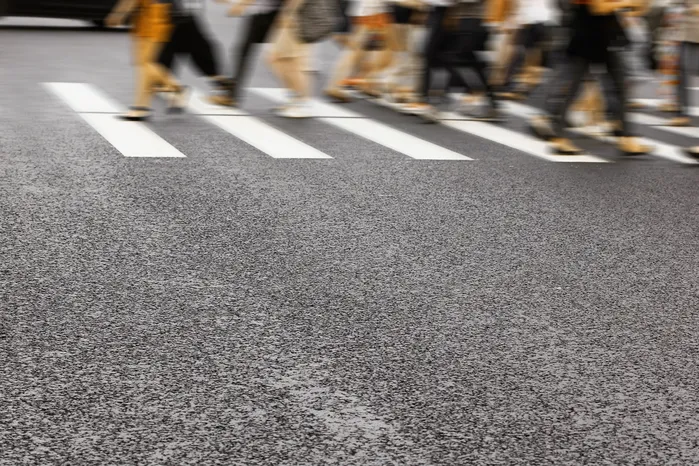7 min read time
Table of Contents

Nevada Bicycle Laws
As you navigate Nevada's roads, it's essential to understand the Nevada bike laws that apply to both bicyclists and motor vehicle drivers.
Below, we'll explore the rules of the road for bicyclists, including wearing helmets, riding in designated bike lanes, and exercising caution at red lights and wearing reflective material during night hours.
Whether you're a seasoned cyclist or just starting out, knowing these regulations can help keep you safe on Nevada's roads and avoid liability in a bicycle accident or fines from violating traffic laws.
Overview of Key Nevada Bicycle Laws
The State of Nevada has bicycle laws that apply to both bicycle riders and motor vehicle drivers. These bicycle rules allow bicyclists to use the same road as motor vehicle drivers, but require bicyclists to exercise caution and stay as close to the right side of the road as possible in order to prevent bike accidents.
Drivers must also leave at least 3 feet for bicyclists, ensuring the safety of both bicyclists and drivers.
Bicyclists are expected to follow local ordinances and traffic signals and have a duty to operate with due regard for the safety of others on the road. Neither bicyclists nor motor vehicle drivers may intentionally interfere with each other on the road.
Bicycles Are Considered Vehicles in Nevada
In the State of Nevada, bicycles are considered vehicles and are subject to the same traffic laws as cars. With a vehicle classification, bicyclists have the right to use the road and can ride safely in designated bicycle lanes in the Las Vegas area, but they must stay as close to the right side of the road as possible while avoiding nearby traffic.
Where Cyclists Can, and Can't, Ride in Nevada
In Nevada, bicyclists can ride on the roadways alongside traffic, as well as on Carson City area sidewalks, unless Nevada state law or restricted areas dictate otherwise.
You must stay as close to the right side of the road as possible and protect cyclists by following all applicable bicycle lane laws.
Equipment Requirements for Bicyclists in Nevada

When it comes to riding a bike in Nevada, having the right and required equipment, such as a bicycle helmet and bicycle lights, is crucial for safety and compliance with Nevada law.
Required Biking Equipment
To ride a bike in Nevada, you must install certain equipment on your bicycle. According to NRS 484B.783, the required biking equipment includes a lamp on the front which emits wight light from a distance of 500 feet and a red reflector that is visible from 50 to 300 feet for night riding.
This is crucial for ensuring your safety while cycling, especially when biking at night or in low-light conditions. Always make sure to check your bike's lighting system before heading out after dark.
Nevada Bicycle Helmet Laws
Nevada law does not have a helmet requirement for bicyclists. While the state has no legal requirement for riders to wear helmets, the Nevada Department of Transportation and the National Highway Traffic Safety Administration strongly recommend that bicyclists always wear a bike helmet and other cycling accident protection gear.
Visible Clothing
While no state or local laws mandate a person riding a bike to wear reflective clothing, you are encouraged to wear bright-colored clothing to improve your visibility to other people, increasing safety, especially at night.
Traffic Rules and Regulations for Bicycles in Nevada
When riding a bike in Nevada, you must follow the same traffic rules as drivers.
More specifically, you must ride with the traffic flow, keep to the right unless you're about to turn left, keep one hand on the handlebars at all times, and use hand signals before turning.
Turning and Signaling on a Bicycle
Use hand signals to indicate turns unless you're in a designated turn lane or need both hands on the handlebars for safety.
When turning or signaling on a bicycle in Nevada, follow these basic rules:
- To Turn Left: Left arm out
- To Turn Right: Right arm out
- To Stop: Left arm down
These signals must be made at least 100 feet before the intended maneuver.
Traffic Light Rules for Cyclists
While cyclists must follow all traffic lights, like motor vehicle drivers, NRS 484B.307 provides bicyclists with legal steps to take if a red light fails to detect their presence.
These steps to legally proceed through a red light include:
- Come to a complete stop
- Wait two full light cycles
- Yield for crossing traffic
- Proceed through the traffic light
However, many safety experts advise avoiding running traffic lights as a bicyclist, even if done so legally, and instead find an alternative route with a designated bike lane.
Stop Signs and Yield Signs for Cyclists
When approaching stop signs or yield signs while cycling in Nevada, follow the same rules as drivers. Come to a complete stop at all stop signs, avoid making reckless left turns that can lead to bicycle accidents, and proceed only when it is safe to do so.
When yielding, slow down and prepare to stop if necessary. Remember to always use hand signals before turning, unless you're in a turn lane or need both hands on the handlebars for safety.
E-Bikes Regulations in Nevada
If you seek to take your e-bike across the state's roads and trails, it's essential to understand what constitutes an e-bike, how they're classified, and what rules apply to their use.
Overview of Electric Bicycle Classifications
Electric bicycles are classified into three categories based on their motor power and speed. These classifications help determine where you can ride your e-bike and what safety features it must have.
Here are the three classes of e-bikes in Nevada:
- Class 1: Pedal-assist only, up to 20 mph
- Class 2: Throttle-powered, up to 20 mph
- Class 3: Pedal-assist only, up to 28 mph (must have a helmet and follow motorized vehicle laws)
Where You Can Ride an E-Bike
All classes of e-bikes can use public streets, specific highways, bike lanes, and shared-use paths, unless otherwise restricted. BLM and US Forest Service lands may have trail access limitations for e-bikes depending on local rules.
Equipment Requirements for E-Bikes
You must ensure your e-bike meets certain equipment requirements. These include:
- A permanent classification label
- Must meet federal safety standards
- The motor must cut off when pedaling stops or brakes are applied
- Modifications that alter speed/class require an updated label
Age and Helmet Rules for E-Bikes
E-bikes have special rules and suggestions surrounding age and helmet requirements, which are:
- Class 3 riders must be at least 16 years old
- Helmets are required for Class 3 riders under 18
- Helmets are strongly recommended for all e-bike users
Legal Implications of Violating Nevada Bicycle Laws
As a cyclist, you have the same rights and duties as motor vehicle drivers on the road, which also means you must abide by the same traffic laws. Violating these laws can have serious legal implications.
Below, we'll cover the consequences of breaking Nevada's bicycle laws and what you need to know to stay safe on the roads.
Penalties and Fines for Biking Violations
Violating Nevada bicycle laws, including restricting bicycle access, can result in penalties and fines. For example, if you intentionally interfere with a motor vehicle or bike in a restricted area, it's considered a gross misdemeanor and punishable by up to 6 months in jail and/or a fine of up to $1,000.
Additionally, throwing objects at bicyclists is also a misdemeanor, punishable by up to 6 months in jail and/or a fine of up to $1,000.
Legal Consequences of Accidents Involving Cyclists
When an accident occurs involving a cyclist and a motor vehicle, it's essential to understand the legal consequences and what legal options you may be able to explore with a Las Vegas bicycle accident lawyer as a cyclist.
In Nevada, if a driver or bicyclist acts negligently and that action contributes to the bicycle accident, they may be legally liable for the harm caused. Being legally liable for a bicycle accident can result in numerous consequences, including increased insurance premiums, license suspensions, and financial hardships.
If you're injured in an accident while riding a bicycle, it's crucial to seek medical attention immediately and schedule a free consultation with our top Las Vegas bicycle accident attorneys by calling (702) 566-3600.
Proposed Updates to Nevada's Bicycle Laws
With great weather most of the year, bicycling is a popular mode of transportation in Las Vegas, but unfortunately, it's not always bike-friendly, which is why Clark County is seeking to update Nevada bicycle laws.
Assembly Bill 168 - Proposed "Stop as Yield" Rule
If passed, Assembly Bill 168 would introduce a new rule for bicyclists in Nevada: the "stop as yield" rule. This rule would require bicyclists to come to a complete stop at intersections and stop signs, just like motor vehicles do. Currently, bicyclists are only required to slow down or yield when approaching these types of intersections.
The proposed bill aims to improve road safety by reducing conflicts between bicyclists and motorists. By requiring bicyclists to come to a full stop, the rule would help prevent biking accidents caused by bicyclists rolling through stops or not yielding to traffic.
Obtain the Compensation You're Entitled To
Contact Us Today
Rodney Okano Car Accident Lawyer is a Las Vegas personal injury law firm with over 20 years of experience helping clients obtain maximum compensation following injuries from accidents such as car crashes, worksite injuries, and slips and falls. Over those years, The Rodney Okano Car Accident Lawyer Law Firm has become an experienced law firm that can ensure exceptional results for any of its clients.





